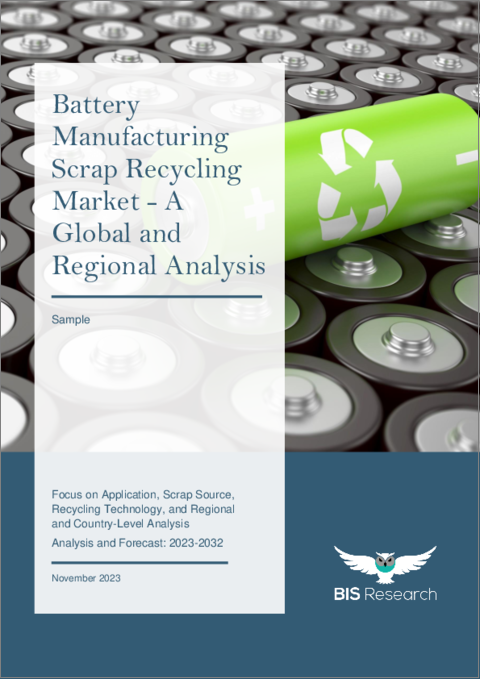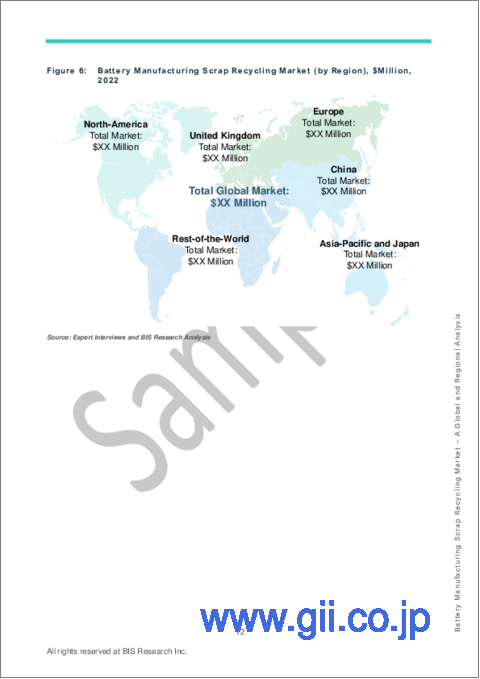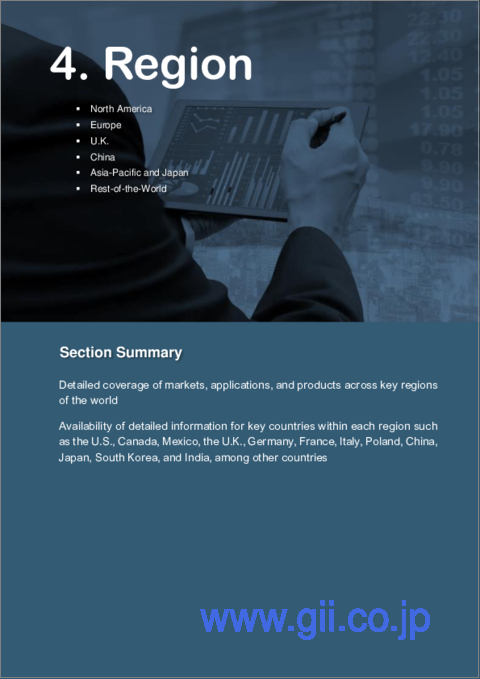|
|
市場調査レポート
商品コード
1394962
電池製造スクラップリサイクルの世界市場 (2023~2032年):用途・スクラップ発生源・リサイクル技術・地域/国別の分析・予測Battery Manufacturing Scrap Recycling Market - A Global and Regional Analysis: Focus on Application, Scrap Source, Recycling Technology, and Regional and Country-Level Analysis - Analysis and Forecast, 2023-2032 |
||||||
カスタマイズ可能
|
|||||||
| 電池製造スクラップリサイクルの世界市場 (2023~2032年):用途・スクラップ発生源・リサイクル技術・地域/国別の分析・予測 |
|
出版日: 2023年12月13日
発行: BIS Research
ページ情報: 英文 107 Pages
納期: 1~5営業日
|
全表示
- 概要
- 図表
- 目次
世界の電池製造スクラップリサイクルの市場規模は、2022年の19億6,000万米ドルから、予測期間中は16.89%のCAGRで推移し、2032年には106億3,000万米ドルの規模に成長すると予測されています。
電池製造スクラップリサイクルは、電池セルの製造過程で発生するスクラップ材の製造を扱う急成長産業です。電気自動車の普及に伴い、これらの電池市場は急速に拡大すると予想され、電池製造スクラップリサイクル技術の拡大にも拍車がかかると考えられています。電池製造スクラップリサイクル市場を独占しているのは、Umicore、BASF SE、Tenova S.p.A.などの主要企業数社ですが、今後数年のうちには多数の競合他社が市場に参入し、競合が激化し、さらなる成長と技術革新に拍車がかかると予想されています。
| 主要市場統計 | |
|---|---|
| 予測期間 | 2023-2032年 |
| 2023年評価 | 26億1,000万米ドル |
| 2032年予測 | 106億3,000万米ドル |
| CAGR | 16.89% |
スクラップ発生源別で見ると、自動車用電池の部門が2022年の市場を独占しました。また、リサイクル技術別では、湿式冶金の部門が2022年の市場を独占しました。湿式冶金はもっとも重要なリサイクル技術の1つであり、主要な産業用途分野の要件を満たしています。さらに、地域別では、中国が2022年に世界市場で約24.8%のシェアを占め、支配的な地域となりました。
主要企業:
|
|
当レポートでは、世界の電池製造スクラップリサイクルの市場を調査し、市場の背景・概要、市場成長への各種影響因子の分析、特許動向、市場規模の推移・予測、各種区分・地域/主要国別の詳細分析、競合情勢、主要企業の分析などをまとめています。
目次
エグゼクティブサマリー
調査範囲
第1章 市場
- 業界の展望
- 動向:現在と未来
- サプライチェーン分析
- 事業力学
- 事業促進要因
- 事業上の制約
- 事業機会
- スタートアップの情勢
- エコシステムにおける主要なスタートアップ企業
- 電池のライフサイクルにおける循環経済の分析
- リチウムイオン電池リサイクル市場の分析
- 電池製造装置市場の分析
- 特許分析
- 世界の平均価格分析
第2章 用途
- 電池製造スクラップリサイクル市場:用途と仕様
- 自動車
- エネルギー・電力
- エレクトロニクス
- 航空宇宙・防衛
- 建設
- その他
第3章 製品
- 世界の電池製造スクラップリサイクル市場:スクラップ発生源と仕様
- 自動車用電池
- 産業用電池
- CE製品用電池
- その他
- 世界の電池製造スクラップリサイクル市場:リサイクル技術タイプと仕様
- 乾式冶金学
- 湿式冶金
- その他
第4章 地域
- 北米
- 欧州
- 英国
- 中国
- アジア太平洋と日本
- その他の地域
第5章 市場:競合ベンチマーキング・企業プロファイル
- 競合ベンチマーキング
- 主要企業の市場シェア:範囲の分析
- 企業プロファイル
- 企業:電池製造スクラップリサイクル市場
第6章 調査手法
List of Figures
- Figure 1: Battery Manufacturing Scrap Recycling Market Overview, $Million, 2022-2032
- Figure 2: Battery Manufacturing Scrap Recycling Market Overview, Kiloton, 2022-2032
- Figure 3: Battery Manufacturing Scrap Recycling Market (by Application), $Million, 2022-2032
- Figure 4: Battery Manufacturing Scrap Recycling Market (by Scrap Source), $Million, 2022-2032
- Figure 5: Battery Manufacturing Scrap Recycling Market (by Recycling Technology), $Million, 2022-2032
- Figure 6: Battery Manufacturing Scrap Recycling Market (by Region), $Million, 2022
- Figure 7: Battery Manufacturing Scrap Recycling Market Coverage
- Figure 8: Supply Chain Analysis for Battery Manufacturing Scrap Recycling Market
- Figure 9: Circular Lifecycle for Battery
- Figure 10: Global Lithium-Ion Battery Recycling Market Analysis
- Figure 11: Global Patents Filed, January 2019-October 2023
- Figure 12: Global Patents Granted, January 2019-October 2023
- Figure 13: Global Patents Filed and Granted, January 2019-October 2023
- Figure 14: Global Patents Filed, January 2019-October 2023
- Figure 15: Research Methodology
- Figure 16: Top-Down and Bottom-Up Approach
- Figure 17: Influencing Factors of the Battery Manufacturing Scrap Recycling Market
- Figure 18: Assumptions and Limitations
List of Tables
- Table 1: Impact of Business Drivers
- Table 2: Impact of Business Restraints
- Table 3: Impact of Business Opportunities
- Table 4: Key Start-Ups in the Ecosystem
- Table 5: Average Global Level Pricing Analysis, Battery Manufacturing Scrap Recycling Market, $/Ton, 2022-2032
- Table 6: Battery Manufacturing Scrap Recycling Market (by Region), Kiloton, 2022-2032
- Table 7: Battery Manufacturing Scrap Recycling Market (by Region), $Million, 2022-2032
- Table 8: Market Share Analysis, Global Battery Manufacturing Scrap Recycling Market (by Key Company), 2022
“Global Battery Manufacturing Scrap Recycling Market Expected to Reach $10.63 Billion by 2032.”
Market Overview
The global battery manufacturing scrap recycling market was valued at $1.96 billion in 2022, and it is expected to grow at a CAGR of 16.89% to reach $10.63 billion by 2032. The battery manufacturing scrap recycling is a fast-expanding industry that deals with the manufacturing of scrap materials generated during the manufacturing process of battery cells. The market for these batteries is anticipated to expand rapidly as electric vehicles gain popularity, which will also fuel the expansion of the battery manufacturing scrap recycling technologies. In addition, there are a few key players who dominate the battery manufacturing scrap recycling market, including Umicore, BASF SE, Tenova S.p.A., and many more. Nonetheless, a large number of new competitors are anticipated to enter the market in the upcoming years, increasing competition and spurring additional growth and innovation.
| KEY MARKET STATISTICS | |
|---|---|
| Forecast Period | 2023 - 2032 |
| 2023 Evaluation | $2.61 Billion |
| 2032 Forecast | $10.63 Billion |
| CAGR | 16.89% |
Market Lifecycle Stage
The global battery manufacturing scrap recycling market is in a growing phase. New trends, such as targets for ethical supply chain and decarbonization, increasing focus toward secondary battery materials, rising investments in recycling technologies, change in business models of companies due to climate action, increasing demand for lithium-ion batteries and raw materials across the value chain, and development of economic and environmental technologies, are further expected to provide opportunities for the market to grow in the coming years.
Industrial Impact
Battery manufacturing scrap recycling market has a large industry influence since it provides numerous environmental and economic benefits. Furthermore, it has a significant effect on end-use sectors since it provides a plethora of benefits that can increase their efficiency, lower their costs, and give them a consistent source of important metals.
With an increased worldwide focus on circular economic principles and the advancements in recycling technologies for the recovery of high-performance metals from manufacturing scrap, there is an increasing shift toward the demand and consumption of batteries such as lithium-ion in the end-use industries. Thereby creating demand for the recycling of battery manufacturing scrap. Additionally, the shift is more prominent in the automotive and energy sectors in regions such as China, Asia-Pacific and Japan, North America, and Europe.
Market Segmentation:
Segmentation 1: by Scrap Source
- Automotive Batteries
- Industrial Batteries
- Consumer Electronics Batteries
- Others
Based on the scrap source, the automotive batteries segment dominated the global battery manufacturing scrap recycling market in 2022.
Segmentation 2: by Recycling Technology
- Hydrometallurgy
- Pyrometallurgy
- Others
Based on the recycling technology, the hydrometallurgy segment dominated the global battery manufacturing scrap recycling market in 2022. It is one of the most significant recycling technologies, which meets the requirements of major industrial application areas.
Segmentation 3: by Application
- Automotive
- Electronics
- Energy and Power
- Aerospace and Defense
- Construction
- Others
Based on the application, the automotive segment dominated the global battery manufacturing scrap recycling market in 2022.
Segmentation 4: by Region
- North America - U.S., Canada, Mexico
- Europe - Germany, France, Italy, Poland, and Rest-of-Europe
- U.K.
- Asia-Pacific and Japan - Japan, India, South Korea, Australia, and Rest-of-Asia-Pacific and Japan
- China
- Rest-of-the-World - Middle East and Africa and South America
Based on region, in 2022, China was the dominant region, accounting for a share around 24.8% of the global battery manufacturing scrap recycling market.
Recent Developments in the Battery Manufacturing Scrap Recycling Market
- In February 2023, manganese-rich battery material technology for electric vehicles is being industrialized by Umicore. This significant achievement expands Umicore's wide spectrum of nickel, manganese, and cobalt (NMC) battery materials for exceptional productivity and long-range EVs. It also introduces a distinctly competitive technology to existing design-to-cost battery technologies for EVs.
- In September 2022, General Motors Co. and Lithion Recycling invested strategically in Lithion Recycling's Series A fundraising round in support of a new strategic collaboration agreement between the two companies. This investment aims to create a circular battery ecosystem employing Lithion Recycling's cutting-edge battery recycling technology.
Demand - Drivers and Limitations
Following are the drivers for the global battery manufacturing scrap recycling market:
- Increasing Government Regulations toward Battery Waste Management
- Growing Investment in Scrap Recycling from Battery Manufacturers
Following are the challenges for the global battery manufacturing scrap recycling market:
- Complexities Associated with Different Battery Chemistries
How can this report add value to an organization?
Product/Innovation Strategy: The product segment helps the reader understand the different sources from where the batteries are coming for recycling and reaching their best potential globally. Moreover, the study provides the reader with a detailed understanding of the different battery chemistries and their assortments in different batteries employed in various end-use applications in industries such as aerospace, automotive, energy, and sports.
Growth/Marketing Strategy: Business expansions, partnerships, acquisitions, collaborations, and joint ventures are some key strategies adopted by key players operating in this market. For instance, in April 2022, in Europe, Umicore and Automotive Cells Company (ACC) formed a strategic cooperation for EV battery materials. With the first commercial volumes anticipated in early 2024, the long-term arrangement will begin with an annual offtake commitment of 13 GWh to a significant platform of a European automaker.
Competitive Strategy: Key players in the global battery manufacturing scrap recycling market analyzed and profiled in the study involve battery manufacturing scrap recycling providers. Moreover, a detailed competitive benchmarking of the players operating in the global battery manufacturing scrap recycling industry has been done to help the reader understand how players stack against each other, presenting a clear market landscape. Additionally, comprehensive competitive strategies such as partnerships, agreements, and collaborations will aid the reader in understanding the untapped revenue pockets in the market.
Key Market Players and Competition Synopsis
The companies profiled have been selected based on inputs gathered from primary experts and analyzing the company's coverage, product portfolio, and market penetration.
Some prominent names in this market are:
|
|
Table of Contents
Executive Summary
Scope of the Study
1. Markets
- 1.1. Industry Outlook
- 1.1.1. Trends: Current and Future
- 1.1.1.1. Targets for Ethical Supply Chain and Decarbonization
- 1.1.1.2. Increasing Focus toward Secondary Battery Materials
- 1.1.2. Supply Chain Analysis
- 1.1.1. Trends: Current and Future
- 1.2. Business Dynamics
- 1.2.1. Business Drivers
- 1.2.1.1. Increasing Government Regulations toward Facilitating Battery Waste Management
- 1.2.1.2. Growing Investments in Scrap Recycling from Battery Manufacturers
- 1.2.2. Business Restraints
- 1.2.2.1. Complexities Associated with Different Battery Chemistries
- 1.2.3. Business Opportunities
- 1.2.3.1. Increasing Advancements in Recycling Technologies
- 1.2.3.2. Creating Circularity in Battery Manufacturing
- 1.2.1. Business Drivers
- 1.3. Start-Up Landscape
- 1.3.1. Key Start-Ups in the Ecosystem
- 1.4. Analysis of Circular Economy in Battery Lifecycle
- 1.5. Analysis of the Lithium-Ion Battery Recycling Market
- 1.5.1. Leading Countries
- 1.5.2. Leading Companies
- 1.6. Analysis of Battery Manufacturing Equipment Market
- 1.6.1. Leading Companies
- 1.7. Patent Analysis
- 1.8. Average Global Pricing Analysis
2. Application
- 2.1. Battery Manufacturing Scrap Recycling Market- Applications and Specifications
- 2.1.1. Automotive
- 2.1.2. Energy and Power
- 2.1.3. Electronics
- 2.1.4. Aerospace and Defense
- 2.1.5. Construction
- 2.1.6. Others
3. Products
- 3.1. Global Battery Manufacturing Scrap Recycling Market - Scrap Source Type and Specifications
- 3.1.1. Automotive Batteries
- 3.1.2. Industrial Batteries
- 3.1.3. Consumer Electronics Batteries
- 3.1.4. Others
- 3.2. Global Battery Manufacturing Scrap Recycling Market - Recycling Technology Type and Specifications
- 3.2.1. Pyrometallurgy
- 3.2.2. Hydrometallurgy
- 3.2.3. Others
4. Region
- 4.1. North America
- 4.1.1. North America: Country Level Analysis
- 4.1.1.1. United States (U.S.)
- 4.1.1.2. Canada
- 4.1.1.3. Mexico
- 4.1.1. North America: Country Level Analysis
- 4.2. Europe
- 4.2.1. Europe: Country Level Analysis
- 4.2.1.1. Germany
- 4.2.1.2. France
- 4.2.1.3. Italy
- 4.2.1.4. Poland
- 4.2.1.5. Rest-of-Europe
- 4.2.1. Europe: Country Level Analysis
- 4.3. United Kingdom (U.K.)
- 4.4. China
- 4.5. Asia-Pacific & Japan
- 4.5.1. Asia Pacific & Japan: Country Level Analysis
- 4.5.1.1. Japan
- 4.5.1.2. South Korea
- 4.5.1.3. India
- 4.5.1.4. Australia
- 4.5.1.5. Rest-of-Asia-Pacific and Japan
- 4.5.1. Asia Pacific & Japan: Country Level Analysis
- 4.6. Rest-of-the-World
- 4.6.1. Rest-of-the-World: Regional Level Analysis
- 4.6.1.1. South America
- 4.6.1.2. Middle East and Africa
- 4.6.1. Rest-of-the-World: Regional Level Analysis
5. Markets - Competitive Benchmarking & Company Profiles
- 5.1. Competitive Benchmarking
- 5.1.1. Market Share Range Analysis of Key Companies
- 5.2. Company Profiles
- 5.2.1. Companies: Battery Manufacturing Scrap Recycling Market
- 5.2.1.1. Fortum
- 5.2.1.2. Brunp Recycling
- 5.2.1.3. Hydrovolt AS
- 5.2.1.4. Umicore
- 5.2.1.5. Li-Cycle Corp.
- 5.2.1.6. BASF SE
- 5.2.1.7. Tenova S.p.A.
- 5.2.1.8. Duesenfeld
- 5.2.1.9. Aqua Metals Inc.
- 5.2.1.10. Green Li-ion Pte Ltd.
- 5.2.1. Companies: Battery Manufacturing Scrap Recycling Market
6. Research Methodology
- 6.1. Primary Data Sources
- 6.2. Secondary Data Sources
- 6.3. Top-Down and Bottom-Up Approach
- 6.4. Assumptions and Limitations






